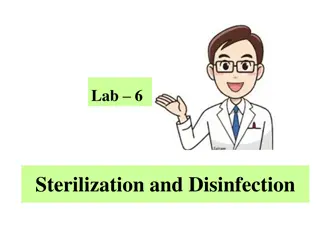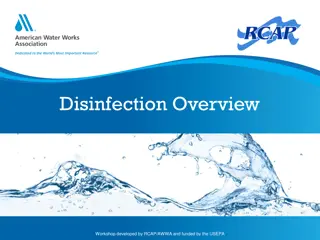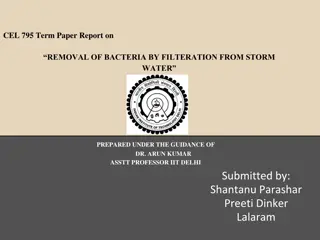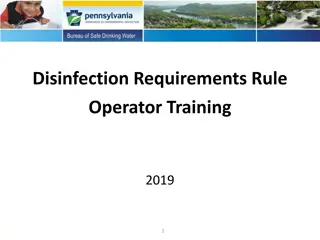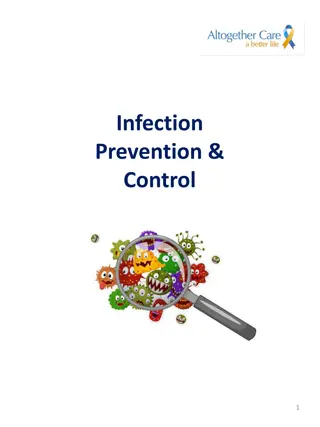Standard Precautions in Dental Settings
Standard Precautions in Dental Settings emphasize the importance of hand hygiene, proper use of personal protective equipment, aseptic techniques, clinical asepsis, and environmental surface disinfection to control infections. Adherence to these precautions minimizes the risk of spreading microorgan
0 views • 21 slides
Best Practices for Disinfection and Sterilization in Healthcare Settings
Explore the application of disinfection and sterilization in various healthcare settings like outpatient facilities, physical therapy, hydrotherapy, gym areas, and portable equipment. Learn about the importance of following strict infection control practices, cleaning protocols, and disinfectant rec
1 views • 27 slides
Water Purification Methods and Techniques Explained
Explore the purification of water on both large and small scales, including storage, filtration, and disinfection processes. Learn about different methods such as boiling, chemical disinfection, and filtration for household water purification. Discover the importance of treatment based on the nature
4 views • 66 slides
Important Guidelines for Ensuring Safety in Medical Environments
Providing guidance on essential practices in medical settings, this collection highlights topics such as cleaning, disinfection, vaccinations, and personal protective equipment. It emphasizes the significance of maintaining cleanliness, following safety protocols, and recognizing high-touch surfaces
2 views • 62 slides
Understanding Sterilization and Disinfection Methods in Laboratory Settings
Sterilization involves killing all microorganisms while disinfection targets pathogenic ones. Various methods like heat, filtration, radiation, and chemicals are used for effective sterilization. Physical sterilization through heat includes dry heat, direct flaming, hot air ovens, and incineration.
4 views • 21 slides
Best Practices for Environmental Cleaning and Disinfection in Healthcare Settings
Effective environmental cleaning and disinfection are crucial in reducing healthcare-associated infections, especially in the context of COVID-19. This webinar by Dr. Lata Kapoor emphasizes the importance of cleaning high-touch surfaces and implementing established cleaning strategies to remove biob
1 views • 18 slides
Guidelines for General Cleaning and Prohibitions in Zamboanga City
The document outlines regulations for general cleaning on Sundays in Zamboanga City, with specific disinfection protocols using bleach and chlorine. It also prohibits social gatherings and non-essential entry of people to and from the Enhanced Community Quarantine zone, except for essential workers
1 views • 13 slides
Hazardous Drug Cleaning and Decontamination Training Overview
This presentation provides an overview of training on deactivating, decontaminating, cleaning, and disinfecting hazardous drug areas. It covers essential steps, personal protective equipment, materials, timing, and validation criteria. All areas handling hazardous drugs must undergo deactivation, de
0 views • 23 slides
Sterilization and Disinfection in Microbiology and Medicine: Importance and Methods
Sterilization and disinfection are crucial in preventing infections in microbiology and medicine. Sterilization involves the destruction of microorganisms, while disinfection targets vegetative bacteria using chemical agents. Factors affecting disinfectant activity include concentration, time of exp
1 views • 7 slides
Hygienic Measures for Poultry Farm Management
Poultry waste management, farm hygiene, sanitation, and environmental issues are critical for maintaining a healthy poultry farm. Disinfection, while important, is not a substitute for cleanliness. Effective disinfectants should have good germicidal activity, be non-toxic to humans and birds, work o
0 views • 18 slides
Effective Infection Control in Port Operations During the COVID-19 Pandemic
Diseases like COVID-19 spread person-to-person through respiratory droplets. Implementing infection prevention measures in ports is crucial to safeguard against outbreaks. Key principles include hand hygiene, use of PPE, and proper sanitation. Countries and organizations recommend screening protocol
0 views • 35 slides
Evolution of Brigada Eskwela: Adapting to the New Normal
Brigada Eskwela, a volunteer program in the Philippines focused on preparing public schools, has evolved over the years. In the traditional concept, it involved physical cleaning, painting, and minor repairs. However, under the new normal due to COVID-19, the program has shifted its focus and extend
0 views • 23 slides
Understanding Tracer Studies and Disinfection in Water Treatment
Tracer studies play a crucial role in determining hydraulic efficiencies and disinfectant exposure times in water treatment processes. This presentation by Guy Schott covers the purpose of tracer studies, water age distribution, disinfection exposure time, CT disinfection, log inactivation, and more
0 views • 34 slides
Microbiological Quality Control in Pharmaceutical Environment
Microbiological products in pharmaceutical settings are influenced by the quality of materials and the environment. Good Manufacturing Practices (GMP) are essential to minimize contamination risks, with control points focused on the ecology of microorganisms. Sources of contamination include the atm
1 views • 128 slides
Essential Guidelines for Chlorine Disinfection in Water Treatment
Learn about the usage and key points to watch for when implementing chlorine disinfection in water treatment processes. Understand the effectiveness, dosing methods, safety considerations, and monitoring protocols to ensure successful water disinfection. Proper handling of hypochlorite solution, mon
1 views • 7 slides
Managing Microbiological Quality in Pharmaceutical Environments
The quality of microbiological products is influenced by the pharmaceutical environment materials. Good Manufacturing Practices (GMP) play a crucial role in minimizing contamination risks. Various sources of contamination include the atmosphere, water, persons, raw materials, packaging, buildings, a
0 views • 128 slides
Comprehensive Overview of Water Disinfection and Chlorination Basics
This workshop explores the importance and various methods of water disinfection, focusing on chlorination basics, chloramines, disinfection types, and the impacts of pH on chlorine disinfection. Learn about the necessity of disinfection in water systems, different disinfectants used, and the need fo
0 views • 37 slides
Guidelines on Sterilization, Disinfection, and Types of Disinfectants in Veterinary Medicine
Sterilization is the process of eliminating all microorganisms from an object, while disinfection reduces the number of pathogenic microorganisms on surfaces. Various types of disinfectants exist, including high-level, intermediate-level, and low-level options. Different equipment items in veterinar
0 views • 18 slides
Maximizing Bacteria Removal from Storm Water through Filteration Research
This term paper report focuses on the removal of bacteria from storm water using different filteration methods. The study reviews research on sand media filters and explores the efficiency of bio sand filters in removing pathogens such as E. coli, Cryptosporidium, and Salmonella. Key findings highli
7 views • 8 slides
High-Quality Disinfection Products to Protect Your Business
Step into a safer, cleaner world with Chemical Essentials\u2019 high-quality disinfection products. \n\nOffering unmatched microbial kill and unrivalled safety, it's the ideal choice for any setting, from laboratories to home kitchens. \n\nIts unique
2 views • 3 slides
Pool Regulation Changes for 2018 - Important Updates for Pool Maintenance
In 2018, David Hornsby, REHS Area Manager, introduced significant changes in pool regulation. These changes include updated minimum disinfectant levels, specific requirements for different pool types such as spas, interactive water play pools, activity pools, wading pools, and more. Additionally, ma
0 views • 31 slides
Biosecurity Cleaning and Disinfection Procedures
This guide outlines biosecurity cleaning and disinfection procedures, including small-scale C&D stations, personal protective equipment protocols, personnel decontamination steps, emergency medical situation guidelines, and equipment sanitation measures. It emphasizes the importance of thorough clea
0 views • 21 slides
Cleaning and Disinfection Personnel Training Guide
This training guide focuses on preparing personnel for effective cleaning and disinfection practices. It covers essential steps such as preparation of disinfectant solutions, biosecurity work zones, basic protocol for cleaning, and procedures in the hot zone. It emphasizes the importance of using EP
0 views • 17 slides
Guidelines for COVID-19 Disinfection of Public Places and Offices
Guidelines from the State Institute of Health and Family Welfare in Rajasthan for the environmental cleaning and decontamination of common public places and offices to combat the spread of COVID-19. The guidelines cover areas like indoor spaces, high-contact surfaces, and office premises, detailing
0 views • 21 slides
Operator Training 2019: Disinfection Requirements Rule Overview
This training course provides a comprehensive overview of the Disinfection Requirements Rule for water system operators. Covering topics such as changes in disinfectant residual requirements, affected water systems, distribution system challenges, and more, operators will gain valuable insights and
0 views • 26 slides
Biosecurity Cleaning and Disinfection Guidelines
The presentation covers the essential components of biosecurity plans, focusing on Cleaning and Disinfection (C&D) as well as Biosecurity Attire/Personal Protective Equipment (PPE). It includes detailed information on C&D methods, processes, and factors affecting disinfecting efficacy, as per the FA
0 views • 19 slides
Essential Guidelines for Sluice and Utility Room Management
Sluices and dirty utility rooms play a crucial role in managing bodily fluids to prevent the spread of infectious diseases. Proper cleaning, disinfection, and maintenance are vital for effective use. This article provides detailed instructions on setting up and maintaining these facilities, includin
0 views • 6 slides
Validation of Hydrogen Peroxide Sterilizers Following ISO 14937 - Klaus Roth SMP GmbH
Klaus Roth SMP GmbH in Tuebingen, Germany specializes in the validation of cleaning, disinfection, and sterilization processes, with a focus on different sterilization methods such as steam, ethylene oxide, formaldehyde, and hydrogen peroxide. They conduct research in prions, test new instrument des
0 views • 25 slides
Physical and Chemical Control of Microbes
This chapter explores the methods of controlling microorganisms through sterilization, disinfection, antisepsis, and sanitization. It discusses the desired level of cleanliness, resistance of microbial forms, and various techniques used to eliminate or inhibit different types of microorganisms.
0 views • 61 slides
Effective Biomedical Waste Management Strategies
Proper management of biomedical waste is crucial for infection control, hazard reduction, cost savings, and legal compliance. Segregation, color coding, disinfection, and proper treatment methods are essential for handling different types of hazardous waste efficiently. Understanding these processes
0 views • 27 slides
Sterilization and Disinfection Methods in Microbiology
Sterilization and disinfection are crucial processes in microbiology to eliminate all microorganisms and prevent their spread. Methods such as heat, ethylene oxide gas, and filtration are employed to achieve sterilization. Physical agents like heat through dry heat, flaming, and hot air ovens, as we
0 views • 27 slides
Importance of Infection Prevention and Control in Healthcare
Infection Prevention and Control is crucial to safeguarding against the spread of harmful microorganisms in healthcare settings. This comprehensive guide covers the definition of infections, types of microorganisms, modes of transmission, the immune system's role, factors predisposing to infections,
0 views • 7 slides
Understanding Disinfection Processes and Mechanisms
Disinfection is the process of partially destroying disease-causing organisms, different from sterilization where all organisms are destroyed. Various mechanisms of disinfectants include damaging cell walls, altering permeability, and inhibiting enzyme activity. Chemical and physical agents such as
0 views • 24 slides
Overview of Cleaning Agents and Disinfectants in Healthcare Settings
Cleaning and disinfection play a crucial role in maintaining hygiene and preventing infections in healthcare settings. Cleaning involves the removal of foreign material from surfaces, while disinfection kills microorganisms. Hospital-grade disinfectants like alcohols, chlorine, phenolics, and hydrog
0 views • 13 slides
Introduction to Python Data Types, Operators, and Expressions
Understanding data types, expressions, and operators is fundamental in Python programming. Learn about Python's principal built-in types such as numerics, sequences, mappings, and classes. Explore numeric types, strings, and their operations like concatenation, escape sequences, and conversions betw
0 views • 20 slides
Understanding Drinking Water Disinfection Byproducts Regulations
This content covers essential information about Stage 2 Disinfection Byproducts (DBP) regulations, including workshop schedules, reasons for plan redoing, acronyms, the purpose of DBP regulations, application to water systems, and carryover from Stage 1 DBP. It emphasizes the risks associated with d
0 views • 36 slides
Enhancing Bacteria Removal from Storm Water through Advanced Filtration Methods
In this term paper report, the focus is on maximizing the removal of bacteria, including pathogens like E. coli, from stormwater using sand media filters. The study reviews current research on sand media filters, compares different filter types, analyzes parameters affecting filter performance, and
0 views • 8 slides
Understanding 4-Log Virus Treatment and Groundwater Rule Compliance
This collection of images and information delves into the importance of 4-log virus treatment under the Groundwater Rule, regulatory requirements for groundwater systems, the basics of Ct calculations for disinfection, types of disinfectants used, and understanding log inactivation of viruses. The c
0 views • 24 slides
Understanding Sterilization and Disinfection Methods
Sterilization involves killing all microorganisms, including bacterial spores, using physical, chemical, and mechanical methods. Disinfection, on the other hand, focuses on removing microorganisms using disinfectants. Chemical methods like antiseptics and disinfectants play a crucial role in ensurin
0 views • 18 slides
Essential Concepts in Sterilization and Disinfection Practices
Understanding the principles of sterilization and disinfection is crucial in medical settings. This lecture covers topics such as defining sterilization, disinfectants, and antiseptics, different methods of sterilization (physical and chemical), the significance of heat sterilization, dry and moist
0 views • 19 slides




